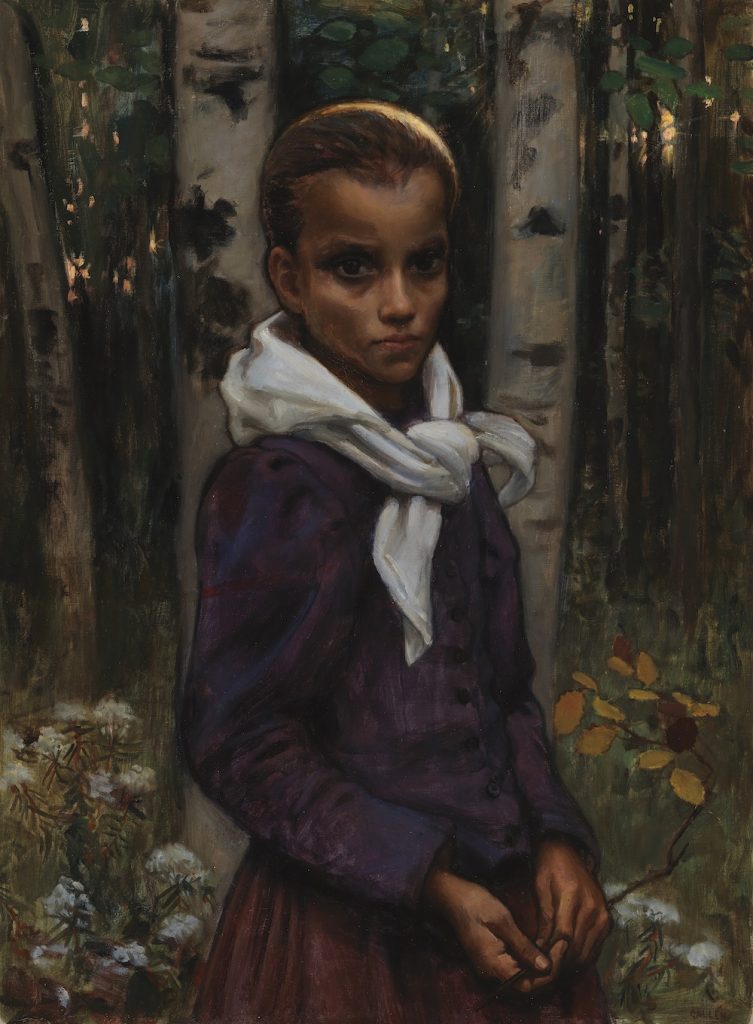Artwork and infectious diseases
JANUARY 2022
Standing in a summery forest amid blooming Labrador tea or Ledum glandulosum and holding a dried-up aspen twig in her hand, a wide-eyed young girl looks out of the painting and reminds us, who live the era of current pandemic, of the infectious diseases that now mainly already have been defeated.
The 12-year-old girl from Lahomäki croft in Ruovesi, Vilhelmiina Ruhanen (1884–1961) who recently had recovered from typhoid fever, had been sitting for Akseli Gallen-Kallela for the work Girl (1895–1996). The child’s leanness and clothes that have become loose on her, her hollow cheeks, thin hair, and shadows underneath her great staring eyes give an account of the strains of the disease. Her intensive gaze is directed at the viewer challenging them to bear witness to her suffering. Even though the girl is standing in a summery birch forest surrounded by Labrador tea, the yellowed aspen twig in her hand alludes to autumn and death.
Immortalised in the painting, Vilhelmiina, however, recovered from her illness and grew up to become an adult. In her lifetime, typhus, which was transmitted through dirty drinking water, disappeared from the most parts of Europe and United States due to improved water and sewage lines.
The dark gaze of the child and the withered aspen twig she is holding in her hand seem to give form to an earlier fatal case of infectious disease: the artist’s first borne daughter Impi Marjatta had perished from diphtheria in 1895. The infectious disease transmitted by saliva caused recurring epidemics until early 20th century and killed especially children. Subsequently, the improvement of the level of hygiene and nutrition as well as comprehensive vaccination rates have made it extremely rare in Europe.
Unvarnished depiction of illness, suffering and social ills was a part of naturalistic concept of art to which Gallen-Kallela subscribed in his early career. He depicted the harsh life as well as illness for example in the sketch Clandestine Birth (1885) and painting Wound Fever (1889). In the next decade, elements hinting towards the trends of symbolism and spiritualism gradually creeped into his art and merged with hearty depiction of common people. In the painting Head of Christ (1895), the halo transforms the barren man of the people into Christ. On the other hand, in the work Girl, the rays of sun in the child’s hair crown the figure of the disease-stricken croft girl with a halo generally reserved for saints and martyrs. Also, the highlighted contours and the contrast between the yellow light and violet dress twist the work from realistic depiction of the common people toward symbolism.
Around the same time, Gallen-Kallela dealt with the demarcation of life and death in the more explicitly symbolistic Kalevala-themed painting Lemminkäinen’s Mother (1897). In the work painted in fully synthetic style with its clear contours and strong black, red and white colour fields, the artist has chosen to depict the deepest hour of despair in the story: Lemminkäinen’s Mother has descended to Tuonela, gathered the parts of her son’s body from the River of Tuonela and unsuccessfully tries to revive the young man. In the Kalevala-themed version of Christian Pietá, Gallen-Kallela’s models for the painting were himself and his mother whose sharp features and intensive gaze were already foreshadowed in the pointy features of the model, earlier painted in the Girl. And, as was the case with Vilhelmiina painted in the summery forest, also in the story of Lemminkäinen life prevails in the end, as the nectar of the bee brings the hero back to life.
Petra Lehtoruusu
Curator


